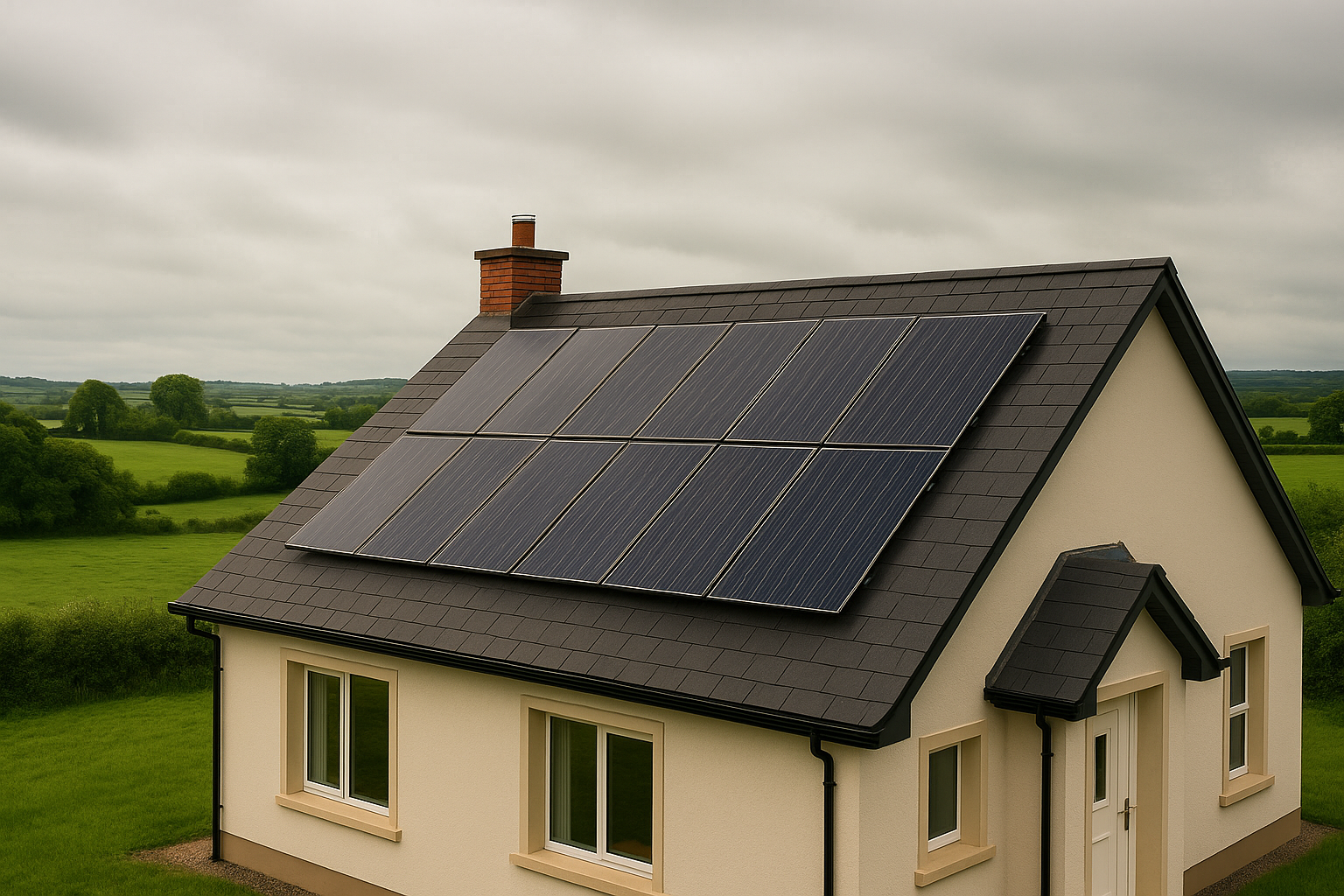Do Solar Panels Work Well in Irish Weather?
Solar panels efficiently harness energy in Ireland's cloudy and rainy weather, making them a viable investment for homeowners.

Yes, solar panels work effectively in Ireland, even with its cloudy and rainy weather. Modern solar panels are designed to generate electricity not just from direct sunlight but also from diffuse light, making them suitable for Ireland's overcast skies. Here’s why solar panels are a smart choice for Irish homeowners:
- Cloudy Days: Panels can produce 60–80% of their capacity under light clouds and 10–25% on heavily overcast days.
- Rain Benefits: Rain naturally cleans panels, helping maintain efficiency, though occasional manual cleaning is still needed.
- Cooler Temperatures: Ireland’s mild climate prevents overheating, which supports optimal performance.
- Annual Output: A standard system generates about 850 kWh per kWp annually, with southern and eastern counties like Wexford outperforming northern areas like Donegal.
With proper installation (south-facing, 30–35° tilt) and high-efficiency monocrystalline panels, solar systems can deliver reliable energy year-round. Government incentives, such as grants and the 0% VAT rate, further reduce costs, making solar a practical and cost-effective investment in Ireland.
Myth Busting - Can Solar Panels Work in Ireland? #SolarIreland
How Solar Panels Work in Cloudy and Rainy Weather
Modern solar panels are designed to capture diffuse light, allowing them to generate energy even when the sun isn’t shining brightly. These panels rely on photovoltaic cells to convert both direct sunlight and scattered, diffuse sunlight into electricity. So, even when clouds blanket the sky, they scatter sunlight rather than completely blocking it, enabling solar panels to keep producing energy.
Cloud Cover and Solar Output
The amount of energy solar panels generate on cloudy days depends on the density and thickness of the cloud cover. For instance, during light or partly cloudy conditions, solar panels can still achieve 60%–80% of their maximum output. This means that even on those typical Irish days with intermittent clouds, your solar system can still perform efficiently.
On heavily overcast days, energy production drops to about 10%–25% of the panels’ capacity. While this might seem modest, it still contributes to your overall energy needs over time.
To maximize performance in cloudy climates like Ireland’s, high-efficiency monocrystalline panels are an excellent choice. These panels are specifically designed to capture more energy from diffuse light, making them particularly well-suited for regions with frequent cloud cover.
Rain: Challenges and Advantages
Rainy weather also affects solar panel performance in unique ways. Even during rainfall, panels can generate about 20%–30% of their optimal output, which still translates into meaningful energy savings.
Interestingly, rain offers a natural cleaning benefit. It helps wash away dust and debris that can accumulate on the panels, improving their long-term efficiency. However, rain alone isn’t enough to keep panels completely clean. Occasional manual cleaning remains important to maintain peak performance. In Ireland’s climate, the combination of frequent rain and occasional cleaning creates a low-maintenance routine for keeping panels in top shape.
Proper installation is especially crucial in rainy regions. For Ireland, panels should be installed at an optimal angle of 30 to 35 degrees, facing south. This positioning allows panels to capture maximum diffuse sunlight on cloudy days while also ensuring rainwater runs off effectively, preventing debris buildup. With this setup, your solar panels can perform efficiently in Ireland’s rainy and cloudy weather year-round.
Solar Energy Production by Season in Ireland
Ireland's changing seasons play a big role in solar energy production, which is essential to consider when planning energy systems. Let's explore how solar output shifts with the seasons and how different regions perform across the country.
Summer vs. Winter Output
Solar panels in Ireland perform best during spring and summer, producing 60–70% of their potential energy. This is thanks to longer daylight hours, higher sun angles, and more direct sunlight.
In contrast, the months from October to February see a drop in production, with panels generating about 25% of their potential output. While winter production is lower, cooler temperatures actually improve panel efficiency by reducing the risk of overheating. Additionally, the albedo effect, where sunlight bounces off snow, can boost solar energy output by as much as 10% during snowy periods.
The surplus energy generated during the sunnier months can help balance out the reduced production in winter, providing a more consistent energy supply across the year.
Regional Differences in Solar Potential
Seasonal changes are only part of the story - location also plays a major role in solar energy performance. Generally, counties in southern and eastern Ireland outperform their northern and western counterparts. For instance, the "sunny southeast" consistently delivers the highest solar output, while areas like Donegal in the northwest see lower production levels.
Take County Wexford as an example: solar panels there generate 9.2% more energy than the national average. On the other hand, County Donegal's output falls 7.6% below the average. This means the same solar system installed in Wexford could produce up to 18.1% more energy than one in Donegal. Interestingly, some counties like Dublin and Wicklow - despite being further north - can outperform southern counties such as Cork and Kerry due to their sunnier weather patterns.
| County | Annual Solar Generation (kWh per kWp) | Compared to National Average |
|---|---|---|
| Wexford | 965 kWh | +9.2% |
| Waterford | 949 kWh | +7.4% |
| Wicklow | 947 kWh | +7.1% |
| Dublin | 915 kWh | +3.5% |
| Carlow | 911 kWh | +3.0% |
| Cork | 907 kWh | +2.6% |
| Kilkenny | 905 kWh | +2.3% |
| Kerry | 896 kWh | +1.3% |
| Clare | 888 kWh | +0.5% |
| Donegal | 817 kWh | –7.6% |
With Ireland's national average at 884 kWh/kWp, even counties with lower output still generate a significant amount of solar energy, making solar panels a worthwhile investment across the country.
For the best results, work with local solar experts who can help you maximize your system's performance.
How to Improve Solar Panel Performance in Irish Weather
To get the most out of solar panels in Ireland's often cloudy and rainy conditions, it's essential to focus on smart planning and the use of advanced technology. While the weather may not always seem ideal, careful installation and modern innovations can make a big difference in system performance.
Best Installation Practices
The foundation of great solar performance lies in proper installation. Key factors like the direction and angle of the panels are especially important. In Ireland, panels are usually installed facing south with an optimized tilt to capture as much sunlight as possible throughout the year.
It's also critical to choose a location free from shading during peak sunlight hours (10:00 AM–4:00 PM). Shade during these times can significantly reduce energy output.
Given Ireland's coastal winds, a sturdy mounting system is a must. Using durable mounting hardware and hiring professional installers ensures your panels stay secure, even in strong winds. Regular maintenance, like cleaning off debris, also helps keep your panels running efficiently.
Technologies for Irish Conditions
Modern solar panels are designed to work well even in less-than-perfect weather. High-efficiency photovoltaic cells, for instance, are excellent at capturing scattered sunlight, which is ideal for Ireland's frequent cloudy days.
- Monocrystalline panels: These are known for their excellent performance in low-light conditions, high efficiency, and durability. While they may cost more upfront, their output often makes them worth the investment in Ireland.
- Polycrystalline panels: A more budget-friendly option, these panels perform reliably on overcast days. However, they usually require more space to produce the same energy as monocrystalline panels.
- Thin-film panels: These panels are lightweight and work well in variable temperatures and low-light conditions. For instance, First Solar's Series 6 panels are highly durable, while flexible options from MiaSolé can adapt to a variety of installations.
"Modern solar panels are more efficient and durable, allowing them to generate electricity even on cloudy days." – PVknowhow.com
Battery storage is another game-changer. It allows you to store excess energy produced on sunny days for use when sunlight is scarce. Pairing this with efficient solar inverters ensures that the energy from your panels is converted smoothly for home use, even when solar production fluctuates.
Here's a quick comparison of panel types suited for Irish weather:
| Panel Type | Best For Irish Conditions | Key Advantages | Recommended Brands |
|---|---|---|---|
| Monocrystalline | Low-light performance | High efficiency, durability | Peimar, SunPower, LG |
| Polycrystalline | Cost-effective reliability | Budget-friendly, good in overcast | Canadian Solar, Trina Solar |
| Thin-film | Variable temperatures | Lightweight, flexible | First Solar Series 6, MiaSolé |
New Solar Technologies
Emerging technologies are making solar panels even more effective in challenging weather conditions.
- Bifacial panels: These can capture sunlight from both sides, increasing energy generation, particularly in areas with variable light conditions.
- Solar tiles: These combine functionality with aesthetics, blending seamlessly with traditional roofing while producing energy.
- Energy storage systems: Devices like the Tesla Powerwall store excess energy generated on sunny days, ensuring you have power during cloudy periods.
- Hybrid systems: By combining solar panels with other renewable sources like wind power, hybrid setups offer a steady energy supply even when solar output drops.
"Innovations in solar technology and energy storage solutions are enhancing efficiency and helping to tackle weather-related challenges." – Sunbase Data
Looking ahead, perovskite solar cells are a promising development in solar technology. These cells, still in the research phase, aim to deliver higher efficiency and better performance in low-light environments.
Government Support for Solar Panels in Ireland
In Ireland, government initiatives are a key driver in making solar energy an appealing and practical investment. By offering financial incentives, the Irish government helps reduce upfront costs and improve the financial returns for both homeowners and businesses. These programs are particularly valuable in balancing the challenges posed by Ireland’s unpredictable weather.
For residential properties, two standout incentives are the Solar Electricity Grant and the 0% VAT rate on solar panel installations. These measures significantly lower the initial investment required, making solar energy more accessible to homeowners.
Another benefit for homeowners is the Microgeneration Support Scheme (MSS), which allows individuals to sell any excess electricity they generate back to the grid through feed-in tariffs. This creates an opportunity to offset energy costs during times when solar production is lower.
Businesses also have access to tailored incentives. The Accelerated Capital Allowances (ACA) program provides tax advantages by allowing businesses to deduct the cost of solar installations more quickly. Additionally, funding is available for community projects, such as solar installations for schools and community centers, to encourage broader adoption.
The Sustainable Energy Authority of Ireland (SEAI) plays a vital role in supporting these efforts. They offer energy assessments and technical advice to help optimize solar installations based on local conditions, ensuring users get the most out of their investment.
These government-backed programs, aligned with Ireland’s broader Climate Action Plan, make solar power a financially viable option despite the country’s variable weather. For those interested in taking advantage of these incentives, Get Solar Panels provides expert guidance to simplify the application process and ensure you maximize available benefits.
Conclusion: Solar Panels Work Well in Irish Weather
Even with Ireland's well-known clouds and rain, solar panels prove to be a highly effective energy solution. Modern advancements in solar technology have shown that panels can perform efficiently even under diffuse sunlight, dispelling the myth that Ireland's climate is unsuitable for solar energy.
Thanks to their ability to harness energy from scattered sunlight, solar panels thrive in Ireland's conditions. Rain even helps by naturally cleaning the panels, while cooler temperatures can enhance their efficiency. Technologies like bifacial panels and perovskite cells further improve energy capture, ensuring consistent performance. While summer months yield higher energy output, winter still plays a meaningful role in contributing to overall annual generation, ensuring year-round benefits.
Government initiatives like the Solar Electricity Grant, 0% VAT, and the Microgeneration Support Scheme make solar energy more accessible and financially viable. These programs, supported by the Sustainable Energy Authority of Ireland, reduce upfront costs and offer opportunities for long-term savings and even income generation.
Beyond financial advantages, solar energy aligns with Ireland's Climate Action Plan by reducing carbon footprints and promoting sustainability. The combination of immediate savings, long-term economic gains, and environmental benefits highlights why solar energy is a smart choice for Irish property owners.
For those considering solar panels, Ireland's weather should not be a concern. With the right planning, high-quality equipment, and professional installation - resources like Get Solar Panels can help - solar systems can deliver consistent and substantial benefits, proving to be a reliable investment in Ireland's unique climate.
FAQs
Do solar panels work efficiently in Ireland's winter weather?
Yes, solar panels can still perform effectively during Ireland's winter months. Even with shorter days and reduced sunlight, solar panels are designed to capture light through clouds and can generate electricity even when there’s light snow. In fact, cooler temperatures can actually boost their efficiency since solar panels tend to work better in cooler weather compared to extreme heat.
To get the most out of your panels during the winter, make sure they’re installed at the optimal angle to catch as much sunlight as possible. It’s also important to keep them free from debris or snow. With these steps, solar panels remain a dependable source of energy throughout the year, even in Ireland's often overcast winters.
What financial incentives are available for Irish homeowners to install solar panels?
Irish homeowners have access to government grants designed to cut the costs of installing solar panels. One notable option is the grant from the Sustainable Energy Authority of Ireland (SEAI), which offers up to €1,800 to help cover installation expenses. This support makes switching to renewable energy more affordable while also helping to reduce electricity bills over time.
On top of that, Ireland’s zero-VAT policy on solar panels means even greater savings on installation costs. With these incentives in place, now is a great opportunity to consider solar energy for your home.
Can solar panels perform efficiently in Ireland's cloudy and rainy weather?
Yes, solar panels can work effectively even in Ireland's cloudy and rainy weather. Thanks to advancements in technology, modern solar panels are designed to harness diffused sunlight, allowing them to generate energy even when the sun isn’t shining brightly. On cloudy days, their efficiency might drop by 10-25%, but with proper installation and upkeep, you can still get solid performance.
To get the best results, position your panels at an angle of 30 to 35 degrees and face them south. This setup helps capture the maximum sunlight over the course of the year. Regular cleaning is also essential to ensure dirt or debris doesn’t block sunlight, though Ireland’s frequent rain often does the job naturally. With the right approach, solar panels can provide a dependable energy source, even in Ireland’s famously unpredictable weather.

